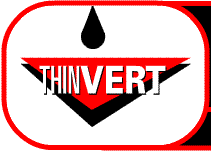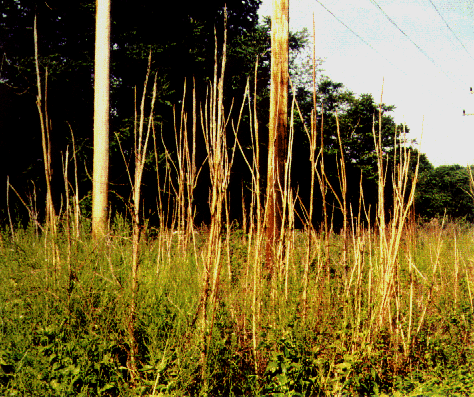 |
 |
|||||||||

|
|
Forestry Aerial applications were made to forest sites in VA, MD, and DE in 1991 using a TVB Spray Boom and .020" TVB wedge nozzles mounted on a Bell G47 Helicopter. Plots nine acres in size were applied comparing triclopyr amine and ester in water and with THINVERT as a carrier. Spray volume was 4 gal/A on all treatments. Evaluation 350 days after treatment (DAT) showed that hardwood control with triclopyr amine in THINVERT was equal to triclopyr ester in water, and superior to the amine in water. The amine salt is usually much less effective than the ester, but is desirable because it is non-volatile. ARSENAL applied in MD and DE in THINVERT gave more early necrosis and more hardwood control 420 DAT than ARSENAL in water plus surfactant. No off-target injury was observed from treatments using THINVERT as a carrier. Small Grains, Phragmites and Melaleuca In 1992 and 1993, aerial applications using the new THINVERT Nozzle were made to forests in ME and VA. In addition, Harmony was applied to winter wheat in DE, and ARSENAL to Phragmites in DE, at spray volumes of 1 to 2 gal/A, with THINVERT treatments controlling target vegetation better than conventional treatments, and with no off-target injury. Aerial applications of Rodeo, ARSENAL, and Garlon 3A in THINVERT carriers were made to control Melaleuca and other aquatic and marginal weeds in Everglades National Park in February 1993. These extensive trials were sponsored by the National Park Service and The South Florida Water Management District. Initial results show good control from all THINVERT treatments. Evaluation in 1994 showed THINVERT applications to be equal to or better than conventional applications in water at higher spray volumes. Sugarcane Commercial aerial applications of furadan for borer control in sugarcane in LA were four times as effective using THINVERT as a carrier compared to a water carrier. Both sprays used THINVERT Aerial Nozzles. Spray volume was 1 gal/A. The high toxicity of furadan makes targeting very important, both for humans and fish. Successful work was also completed with Guthion which is also highly toxic to fish. Other Applications ACCROBE, an AMCY bacterial mosquito larvicide containing BT, was applied through a Scorpion Mistblower and a cold-fogger in a THINVERT carrier. Evaporation of these fine particles makes deposition difficult with conventional applications. THINVERT as a carrier prevented droplet shrinkage from evaporation and improved target deposition. Droplets settled to the vegetation instead of shrinking and moving off into the atmosphere. Initial studies by Clemson University indicate that potency of the ACCROBE in THINVERT sprays was not reduced. Additional efficacy studies will be conducted in 1994. In August 1992, the THINVERT Application System was demonstrated to Cyanamid Japan personnel at the Talhara Research Facility in Japan. Additional demonstrations were held when many of the same people attended a return session at Waldrum's facility in Doylestown, PA in early 1993. Cyanamid Japan officials felt that the System had much potential for applications to crops and industrial sites in Japan and Southeast Asia. They have made arrangements to purchase THINVERT Nozzles and THINVERT formulations. |
|
Below is a list of the topics for Thinvert. Click on the one you want or simply press the "NEXT" button to see them in order. "Home" returns you to the Waldrum Specialties home page. |
||||
|
|
GROUND APPLICATIONS |
AERIAL APPLICATIONS |
|
|
|
THINVERT CONCENTRATE |
THINVERT Ready-To-Use |
|
FINE TURF |
|
|
THINVERT CONCENTRATE |
THINVERT CONCENTRATE |
THINVERT Ready-to-Use |
|
|
|
|
|
|
|
|
HOME • E-MAIL • RADIARC • THINVERT • TVB
Images, logo and text ©2002 by Waldrum Specialties, Inc.
Questions or comments about this website?
webmaster@waldrumspecialties.com
Page last modified: 17-March-2002